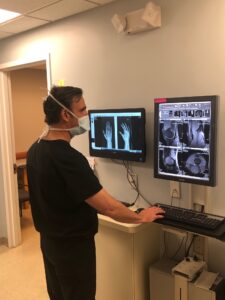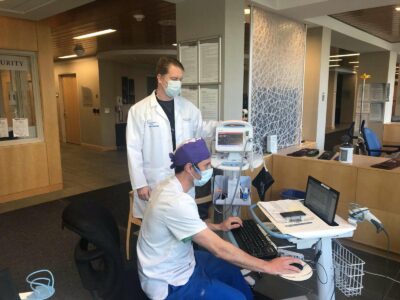To go or not to go to the doctor? That is the question, although the evidence is mounting that avoiding medical care when you are sick is at best, foolhardy. Still, with the threat of COVID-19, the reports of overwhelmed hospitals, and the shutdown of elective surgeries and non-essential medical care, for many the thought of going to a doctor or emergency room can cause the toughest amongst us to break into a sweat.
A new poll from the American College of Emergency Physicians reveals 80 percent of adults say they are concerned about contracting Covid-19 from another patient or visitor if they need to go to the emergency room. The poll further reveals that 29 percent of adults have actively delayed or avoided seeking medical care due to these concerns. An article published yesterday on this site revealed that emergency room avoidance is a problem that has hit close to home, too, increasing the risk of life threatening conditions.
Michele Older, an Edgemont resident, had been trying so hard to avoid going to any doctors during this pandemic, but she had no alternative when her 17-year-old son had an anaphylactic allergic reaction on the evening of April 30th. She was advised by her pediatrician on the phone that despite administering an epi-pen to her son, she had to go to the emergency room. Although afraid, she drove in the pouring rain that night to Maria Fareri Children’s Hospital.
“It was very surreal,” recounts Older. “You couldn’t get into the hospital on your own, you had to knock on the emergency room door, and a nurse covered up in a hazmat suit came to the door and asked several times how old he was before they let me in with him.” Had he been 18 or older, Older would not have been permitted inside due to the stringent precautions all medical facilities are taking due to Covid.“They kept asking about his coughing, which had only started thirty minutes ago because of the allergic reaction, but you could tell they were fearful,” says Older. “Everyone was all masked up and seemed to be very careful and there were people going around cleaning constantly which was good. Everyone just seemed a little stressed, but very nice. It was not crowded and we had a private space. I wouldn’t avoid the hospital if I had another emergency.”
Proving the adage that when it rains it pours, within a week’s time, Older’s son required several other doctor visits unrelated to his allergic reaction. A growth in his nose that had developed after a surgery he had in February for an injury had suddenly become intolerable. Older had put off bringing him to a doctor because of the pandemic, but her son was now complaining that he could not breathe out of his right nostril. She was able to quickly secure an appointment with his ENT specialist, who performed an in-office procedure. Within that same week, Older had tele-health visits with her son’s allergist, his pediatrician, and his gastroenterologist for an unrelated issue. “The tele-health visits were great,” she says. “It normally takes weeks to see the gastroenterologist but we were able to set it up for the next day. He spent thirty minutes with us discussing some test results and I thought it was very convenient.”
The Doctors’ Perspective
Although non-essential in-person medical visits have been discouraged, patients who have possible cancer or abnormal studies have been able to be seen during this pandemic. Dr. Andrew Ashikari, a breast cancer surgeon at The Ashikari Breast Center at the Dobbs Ferry Pavilion of St. Johns Riverside Hospital and a longtime Chappaqua resident, tells his patients “if they are concerned about anything, especially swelling, a lump, or nipple discharge, they should see me regardless of the covid crisis.”
Dr. Ashikari has continued to see patients throughout the crisis since “with breast cancer, you really can’t do a breast exam with tele-health.” He has been seeing new diagnoses “but that slowed down a little because people aren’t getting mammography screenings since they were stopped due to covid. Most patients are coming in with palpable masses and then we are able to order diagnostic imaging.” Unfortunately “it has been a struggle” as many breast imagers were furloughed by radiology groups, but luckily for Dr. Ashikari and his patients, “they actually came in out of the goodness of their heart if I asked them that I needed something biopsied,” he explains.
As far as taking precautions, Dr. Ashikari’s office screens patients by taking their temperatures, making sure they have no cough, wearing masks, spacing people’s appointments out, and putting patients immediately into a room so there is never more than one patient in the waiting room. “I’ve kept my staff hired the whole time and none tested positive or developed antibodies, so we know we’ve been taking the right precautions,” he says.

Dr. Doron Ilan, an orthopaedic hand surgeon at Northeast Orthopaedics and Sports Medicine in Westchester and Rockland Counties and an Armonk dad, has made adaptations to ensure patients get the care they need. “While non urgent surgeries have been postponed, patients with new or recurring injuries and conditions should not delay getting a good evaluation,” advises Dr. Ilan. “Patients continue to get hurt, suffer fractures, lacerations, ligament injuries, pinched nerves and we are here for them. We have instituted a number of options for our patients including telemedicine visits, in-person visits and orthopaedic urgent care where we can see you virtually or in-person the same day in most cases.”
Dr. Ilan’s office has taken numerous steps to keep their offices safe by instituting strict guidelines “including sanitizing each room before every patient, requiring face masks for all staff and patients, pre-screening patients for any illness, social distancing via spacing out visits and online check-in. In partnership with our stand alone surgery centers and outpatient hospital units we have been able to provide our patients with a safe environment to have urgent surgery and we expect to be cleared to do elective surgery in the near future,” he assures.
Dr. Richard Stumacher, Chief of Pulmonary and Critical Care at Northern Westchester Hospital and an Armonk dad, says he has “seen the fear” but people should not avoid getting the care that they need. “For people whose concerns or complaints can wait or can be taken care of by telehealth, it’s ok for them to avoid the ER and instead call their doctor and arrange a virtual visit. It is not ok for them to not see anyone,” advises Dr. Stumacher. But, as far as the people who needed to go to the hospital and did not go on time, “we’ve seen some challenging cases taking care of those who have been avoiding the hospital when they shouldn’t.”
“The truth is,” says Dr. Stumacher,” that now that we’re way beyond the surge and the numbers are coming down, there should be no excuse for anyone not to either contact their doctor, have a virtual visit, go to an office, or even an ER. The harm that they could be doing themselves by continuing to wait can put them at a greater risk than the risk for getting covid, as long as everyone is following proper procedures, wearing masks, and sterilizing everything. Our intervention has proven to be really successful and nobody is currently catching covid from anybody in our hospital.“
Patients’ Challenges
To reduce the risk of exposure, hospitals and doctors’ offices in New York have instituted policies throughout this crisis of only allowing adult patients into their facilities without family members or companions. While most patients understand the rationale behind these rules, it has been difficult for some since having a trusted companion can help ease anxiety over a medical procedure.
“I completely understand why it has to be this way,” says one Armonk mother battling breast cancer, “but it doesn’t stop me from being terrified when I’m dropped off alone to have surgery or when I have to go in for my chemo treatments. Even surrounded by amazing top-notch nurses and doctors, it’s hard to brave it all without your spouse.”
When an in-person visit can be avoided, however, most patients have been opting to delay a visit or take advantage of tele-health. Jennifer Kalapoutis, an Irvington resident, says that one of her daughters has not been getting her routine allergy shots because the allergist is not offering them right now and her other daughter is not going in to her orthodontist to fix a broken bracket in her braces.
“The orthodontist said he would see her if it was causing her pain, but he doesn’t recommend coming in otherwise,” says Kalapoutis. “I don’t want her to be seen. I don’t want to be exposed and I don’t want to expose anyone else.”
Victoria Assa, a Scarsdale resident, was very satisfied with her recent tele-health experience. In lieu of an in-person appointment with her daughter’s endocrinologist who manages her Type 1 diabetes, she scheduled a tele-visit. ”It went very smoothly,” says Assa, “and because of the advanced technology of her pump and her continuous glucose monitor, it was a very seamless appointment because all of the data was sent through the cloud and available to the doctor on her computer. “
Still, the public remains cautious and sub-consciously, many of us are being just a little more careful in our daily lives. Echoing a popular sentiment of many people over the last few months, Assa admits “I’m always thinking don’t take any risks because I don’t want to end up in an E.R.”




